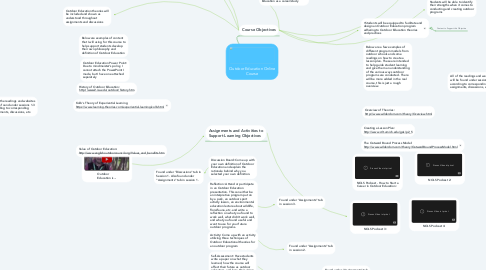Outdoor Education Online Course
by Michelle Nedeau

1. •By end of course, students will develop a personal Outdoor Education philosophy and definition that they will use as an educator
1.1. Content to Support this Objective
2. Course Objectives
3. Outdoor Education Power Point: Due to mindmeister's policy, I cannot attach the PowerPoint I made, but I have one attached separately
4. Outdoor Education is...
5. Kolb's Theory of Experiential Learning https://www.learning-theories.com/experiential-learning-kolb.html
6. Value of Outdoor Education: http://www.englishoutdoorcouncil.org/Values_and_benefits.htm
7. Assignments and Activities to Support Learning Objectives
8. Discussion Board: Come up with your own definition of Outdoor Education and explain the rationale behind why you selected your own definition.
9. Activity: Come up with an activity utilizing three techniques of Outdoor Educational theories for an outdoor program
10. Reflection: Attend or participate in an Outdoor Education presentation. This can either be an interpretive program put on by a park, an outdoor sport activity lesson, an environmental education lecture about wildlife, flora/fauna, etc. and write a reflection on what you found to work well, what didn't work well, and what you found useful and want to use for your future outdoor programs.
11. Self-Assessment: Have students write a paper on what they learned, how the course will affect their future as outdoor educators, and how their vision for creating future outdoor programs.
12. History of Outdoor Education: http://www2.isu.edu/outdoor/history.htm
13. Below are examples of content that I will using for this course to help support students develop their own philosophy and definition of Outdoor Education
14. Students will be able to dictate an overview of the history of Outdoor Education
15. Outdoor Education theories will be included and shown as understood throughout assignments and discussions
16. Found under "Disscusions" tab in Session 1. Also found under "Assignments" tab in session 1.
17. Paper: Have students write a 2 page paper giving an overview of Outdoor Education theories and OE's history. Have students discuss how they will use specific aspects of these theories as they approach the rest of the course and their future in OE.
18. Found under "Assignments" in Session 1.
19. All of the readings and websites will be found under sessions 1-3 according to corresponding assignments, discussions, etc.
20. The Outward Bound Process Model: http://www.wilderdom.com/theory/OutwardBoundProcessModel.html
21. •Students will be equipped to facilitate and design an Outdoor Education program adhering to Outdoor Education theories and practices
21.1. Content to Support this Objective
22. Creating a Lesson Plan: http://www.crlt.umich.edu/gsis/p2_5
23. Overview of Theories: http://www.wilderdom.com/theory/Overview.html
24. NOLS Podcast - How to Start a Career in Outdoor Education:
25. NOLS Podcast 2:
26. NOLS Podcast 3:
27. NOLS Podcast 4:
28. Below are a few examples of different program models from outdoor schools and some readings on how to create a lesson plan. These are intended to help guide student learning and give them an understanding of the various ways outdoor programs are conducted. There will be more added in the real course, this is just a rough overview.
29. Students will develop a repertoire of activities or lessons that they can conduct in their own Outdoor Education programs
30. Students will determine if or how they'd like to pursue Outdoor Education as a career/study
31. Students will be able to identify their strengths when it comes to conducting and creating outdoor programs
32. Found under "Assignments" tab in session 2.
33. Found under "Assignments" tab in session 3.
34. Found under "Assignments" tab in session 3.
35. All of the readings and websites will be found under sessions 1-3 according to corresponding assignments, discussions, etc.


